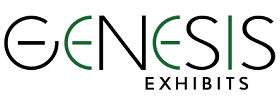What Effect Will AI Have on Trade Show Exhibit Design?
Thoughts on trust, tools, and the evolving creative process.
One of the most rewarding parts of this work is seeing a concept we rendered go from client approval to full production, then walking the show floor and realizing it looks exactly like the rendering. That moment, when a digital vision becomes a real space, is still just as satisfying today as it was when I first started. It reflects the trust, coordination, and detail that go into every project from discovery to delivery.
But exhibit design has never been a fixed formula. It’s subjective. A concept one person loves may be passed over by another. Some projects are won on originality, others on cost. And in today’s compressed timelines, if our first rendering doesn’t hit, we may not get a second shot. That’s why AI tools like Trade Show Maestro (our Genesis Exhibits custom GPT) are gaining traction. Not to replace designers but to help clients sharpen their thought process, faster. These tools allow clients to explore spatial ideas, test visual styles, and even pre-budget concepts before they ever request a rendering. The result: we’re better aligned going into the first round, saving on revisions, design hours, and client frustration.
But not everyone sees this as good news. I spoke recently with a veteran booth designer who put it this way: “What happens when a client uses AI to generate a full layout, and suddenly our role is just to make it buildable? That’s not design, that’s engineering. That’s not why I got into this.” And I get it. As AI becomes more accessible, there’s a real risk that the nuance, strategy, and value of a designer’s expertise gets overlooked especially in procurement-driven RFPs. If clients treat AI concepts as final instead of exploratory, it can edge out the designer’s creative seat at the table. That’s a problem. But it’s also a signal that we need to evolve how we work.
The best outcomes I’ve seen are when AI is treated as a starting point, not a shortcut. Solutions like Trade Show Maestro help clients articulate what they want, what they like (and don’t like) before we start designing. It reduces false starts and lets our team focus on solving the real challenges: structure, materials, messaging, flow.
It also supports smarter design from a sustainability perspective. When we're more targeted, we eliminate waste. We avoid unnecessary reprints. We make design decisions with modularity and reuse in mind, well aligned with the acclaimed EDPA ESCA EIC Sustainability Guidance for Exhibition Stand Construction.
We still need bold ideas, emotional intelligence, visual fluency. That’s where the designer remains irreplaceable. But AI might just help us protect the most important part of our role: bringing the right ideas to life, faster, cleaner, and more confidently.

